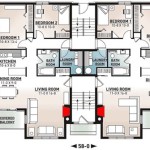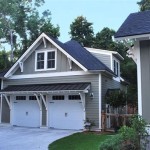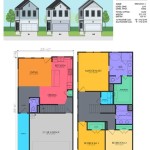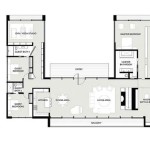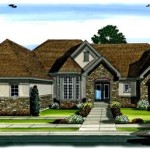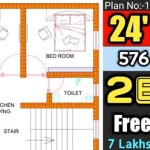2-Story Small House Plans: Maximizing Space and Functionality
The demand for efficient and affordable housing solutions has led to increased interest in 2-story small house plans. These designs offer a compelling alternative to sprawling single-story homes, particularly in areas where land is scarce or expensive. By building upwards, homeowners can maximize the use of a smaller footprint, creating a surprisingly spacious living environment. This article explores the key considerations, benefits, and design possibilities associated with 2-story small house plans.
Key Considerations for Designing a Two-Story Small House
Planning a 2-story small house requires careful consideration of several factors that differ from single-story construction. These aspects directly influence the functionality, comfort, and cost-effectiveness of the final build.
Foundation and Structural Integrity: The foundation of a 2-story house must be significantly stronger than that of a single-story dwelling. The weight distribution is different, requiring deeper footings and reinforced concrete to support the additional load. Structural engineers must be consulted to ensure the building meets local codes and can withstand environmental factors such as wind and seismic activity. Load-bearing walls are critical to the support of the second floor, and their placement needs to be meticulously planned to avoid obstructing desirable layouts.
Staircase Design and Placement: The staircase is a fundamental element of any 2-story house, but it can consume valuable floor space in a small house. Its design and placement are crucial for efficient space utilization and ease of movement. Options include straight staircases, L-shaped staircases, U-shaped staircases, and even spiral staircases, each offering different advantages and disadvantages regarding space consumption and accessibility. The staircase should be positioned centrally or strategically to minimize hallways and maximize the usability of adjacent rooms. Building codes dictate minimum width and rise/run ratios for stairs to ensure safety and accessibility.
Vertical Plumbing and Electrical Systems: Plumbing and electrical systems in a 2-story house require careful planning to minimize installation costs and ensure efficient operation. Stacking bathrooms directly above each other is a common practice to consolidate plumbing lines and reduce the length of pipe runs. Similarly, electrical panels should be centrally located to minimize wiring distance. The placement of water heaters and HVAC systems also needs to be considered, often requiring dedicated utility closets strategically positioned on either floor. Proper insulation is essential to prevent heat loss and maintain energy efficiency throughout the house.
Natural Light and Ventilation: Maximizing natural light and ventilation is crucial in small house designs to create a bright and airy atmosphere. Large windows and strategically placed skylights can significantly enhance the feeling of spaciousness. Proper ventilation helps to remove stale air and prevent moisture buildup. Operable windows on both floors allow for cross-ventilation, promoting airflow and reducing the need for air conditioning. Consideration should be given to the orientation of the house to maximize solar gain in the winter and minimize heat gain in the summer.
Zoning and Local Regulations: Before embarking on any construction project, it is essential to thoroughly research and comply with local zoning regulations and building codes. These regulations can dictate building height restrictions, setback requirements, and minimum lot sizes. Failure to comply with these regulations can result in costly delays and modifications. It is advisable to consult with local planning officials to ensure that the proposed design meets all applicable requirements.
Advantages of 2-Story Small House Plans
Two-story small house plans offer numerous advantages, particularly in areas with limited land availability and a desire for cost-effective housing.
Maximizing Land Usage: Perhaps the most significant advantage is the ability to maximize the use of a small plot of land. By building upwards, a 2-story house provides more living space than a single-story house of the same footprint. This is particularly beneficial in urban areas where land is expensive and building lots are small. The increased vertical space allows for more bedrooms, bathrooms, and living areas without increasing the horizontal footprint.
Cost-Effectiveness: Despite the need for a stronger foundation, 2-story small house plans can be more cost-effective than larger single-story houses. Utilizing a smaller foundation footprint means less concrete is required. Furthermore, the roof area is reduced, leading to lower roofing material costs. The concentrated plumbing and electrical systems can also contribute to cost savings. While the cost of the staircase adds to the overall expense, the savings in other areas often outweigh this cost.
Enhanced Privacy and Views: Building a second story can provide enhanced privacy from neighboring houses and streets. Elevated bedrooms offer a more secluded living space, shielding occupants from street noise and pedestrian traffic. In some cases, a second story can also provide improved views of the surrounding landscape. The increased elevation can offer glimpses of distant scenery that would not be visible from a single-story house.
Distinct Zones for Living and Sleeping: Two-story house plans naturally lend themselves to creating distinct zones for living and sleeping. The ground floor is typically dedicated to living areas, such as the living room, kitchen, and dining room, while the upper floor is reserved for bedrooms and bathrooms. This separation helps to create a quieter and more relaxing sleeping environment. It can also be beneficial for families with different schedules, allowing for activities to continue on the ground floor without disturbing those who are sleeping upstairs.
Potential for Future Expansion: While the initial house is small, the design can incorporate the potential for future expansion. An unfinished attic space, for example, could be converted into additional living space as the family grows. Similarly, a portion of the ground floor could be designed to accommodate a future addition. This foresight allows homeowners to adapt their living space to changing needs without having to move to a larger house.
Design Considerations for Small Two-Story Homes
Designing a 2-story small house requires careful attention to detail to ensure that the space is both functional and aesthetically pleasing. Specific design choices can significantly impact the overall livability and perceived size of the house.
Open Floor Plans: Open floor plans are particularly well-suited for small houses as they create a sense of spaciousness and flow. By eliminating walls between the living room, kitchen, and dining room, natural light can penetrate deeper into the house, making it feel brighter and more open. Open floor plans also facilitate social interaction and make it easier to entertain guests. However, it is important to carefully consider the placement of furniture and appliances to define distinct zones within the open space.
Vertical Storage Solutions: Maximizing vertical storage is essential in small houses. Tall cabinets, shelving units, and built-in storage solutions can help to utilize vertical space effectively. Under-stair storage is another valuable area that can be used for storing seasonal items, cleaning supplies, or even a small home office. Incorporating storage solutions into the design from the outset can help to prevent clutter and maintain a tidy living environment.
Multi-Functional Spaces: Designing rooms that can serve multiple purposes is a key strategy for making the most of a small house. A guest bedroom, for example, could also function as a home office or a playroom. A dining table could double as a workspace. Furniture that can be easily reconfigured or folded away can also help to maximize flexibility. Multi-functional spaces allow homeowners to adapt their living space to changing needs without sacrificing valuable square footage.
Light Colors and Reflective Surfaces: Using light colors on walls, ceilings, and floors can make a small house feel larger and brighter. Light colors reflect light, making the space feel more open and airy. Reflective surfaces, such as mirrors and glossy finishes, can also enhance the feeling of spaciousness. Strategically placed mirrors can create the illusion of depth and make a room feel larger than it actually is.
Minimalist Design Principles: Embracing minimalist design principles can help to create a clutter-free and calming environment in a small house. Minimizing ornamentation, decluttering regularly, and choosing furniture with clean lines and simple designs can contribute to a more spacious and organized living space. Focusing on essential items and avoiding unnecessary possessions can help to create a more streamlined and functional home.
Outdoor Living Spaces: Extending the living space to the outdoors can significantly enhance the livability of a small house. A small patio, deck, or balcony can provide a place to relax, entertain, and enjoy the outdoors. Outdoor living spaces can be seamlessly integrated with the interior through the use of sliding glass doors or French doors. Creating a connection between the indoor and outdoor spaces can make the house feel larger and more inviting.

Small Affordable 2 Story Home Plan North Ina Tennessee House Plans Narrow Floor

Amazing 1000 Ideas About Double Y House Plans On Two Story Small Floor

2 Story House Plans Small Mansion Farmhouse Modern More Blog Floorplans Com

Custom 2 Story Houses New Two Home Plans Housing Development D House Layout Sims Blueprints

10 Small House Plans With Open Floor Blog Homeplans Com

2 Story House Plans For Narrow Lots Blog Builderhouseplans Com

Small House Plans And Floor

Small Two Story House Plans

Small 2 Story House Plans And Smart Tiny Two Level Floor

2 Story House Plans For Narrow Lots Blog Builderhouseplans Com

